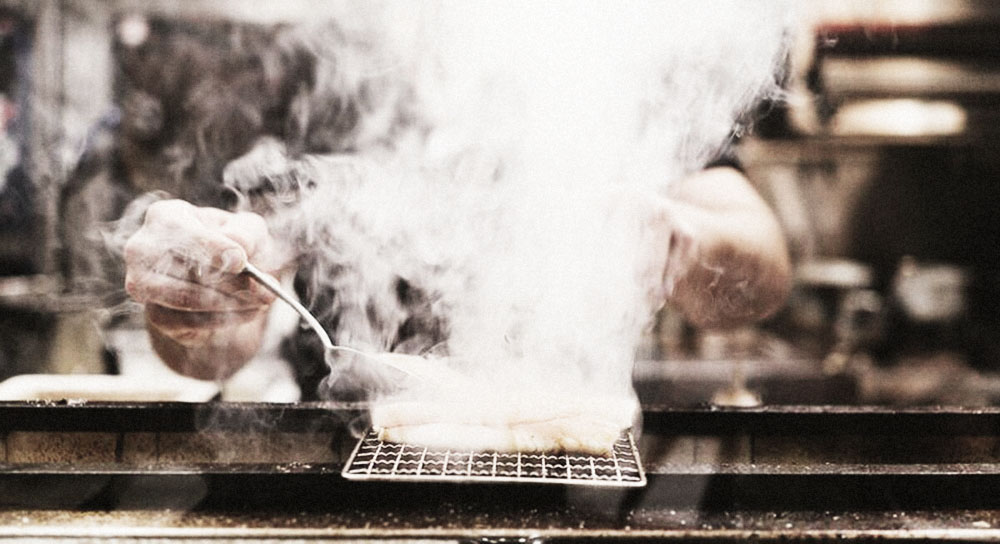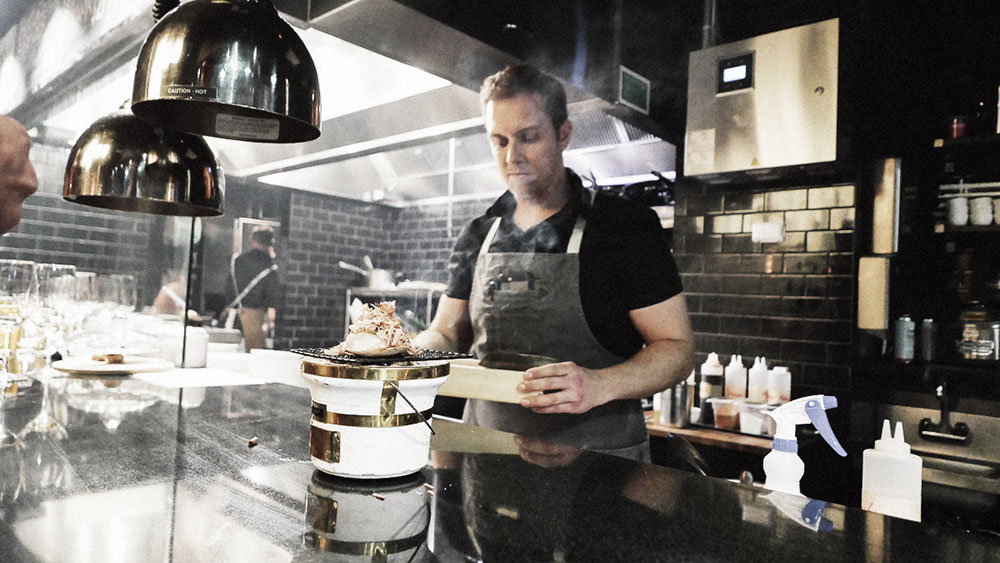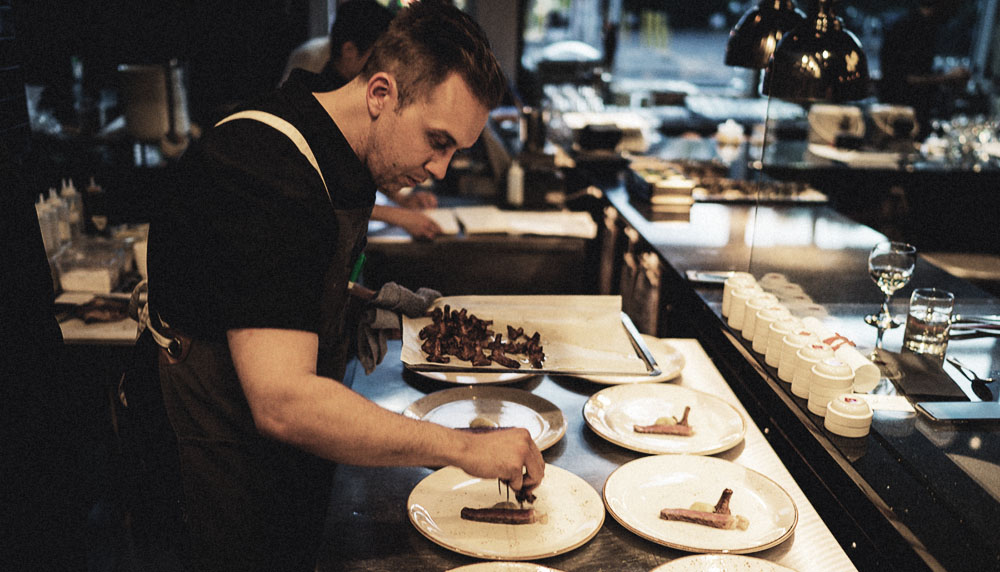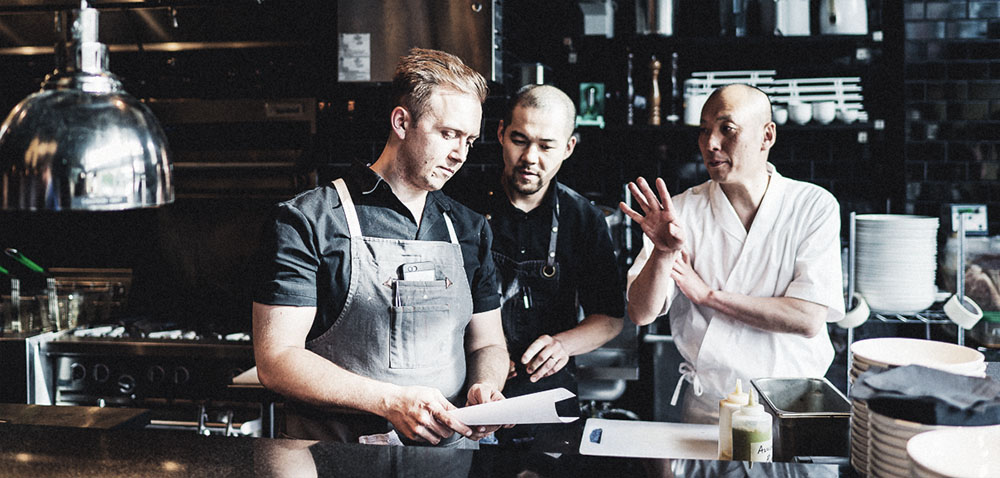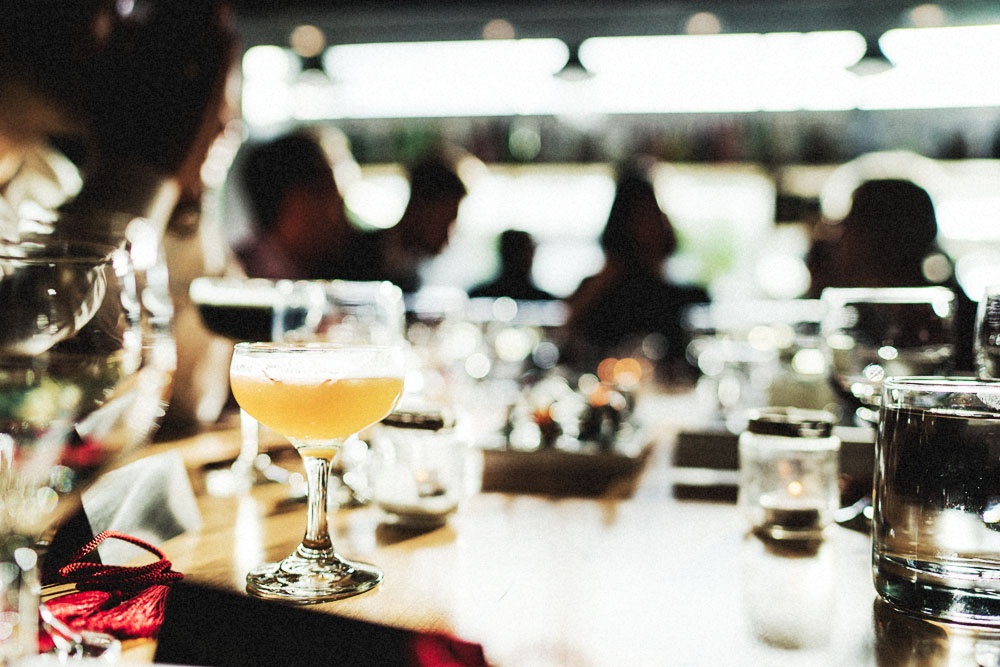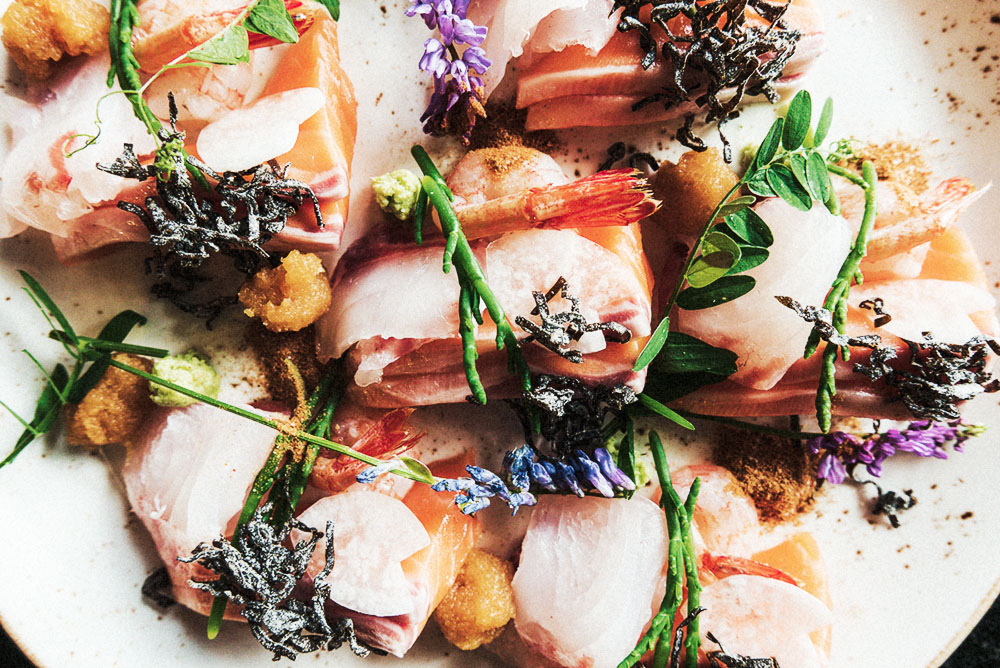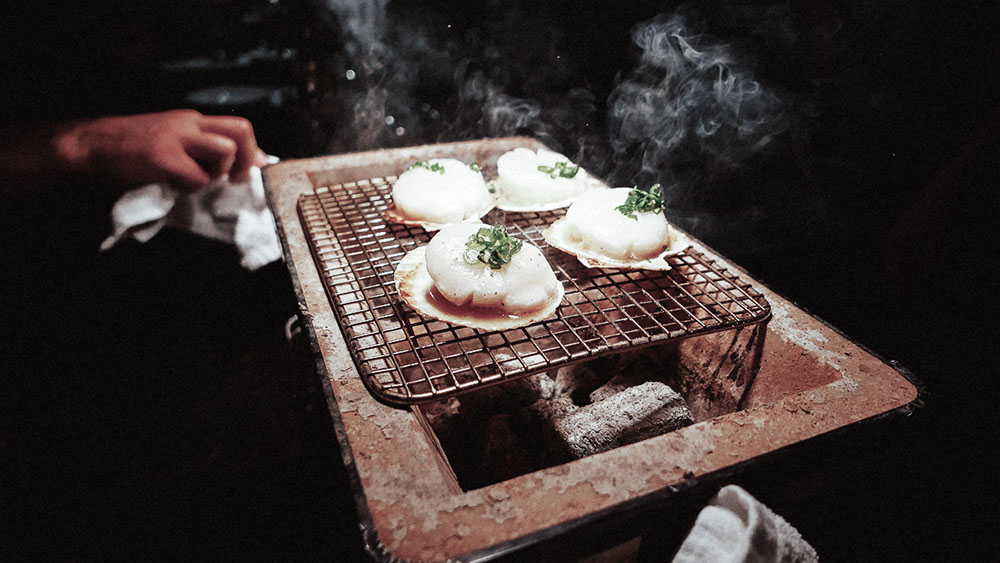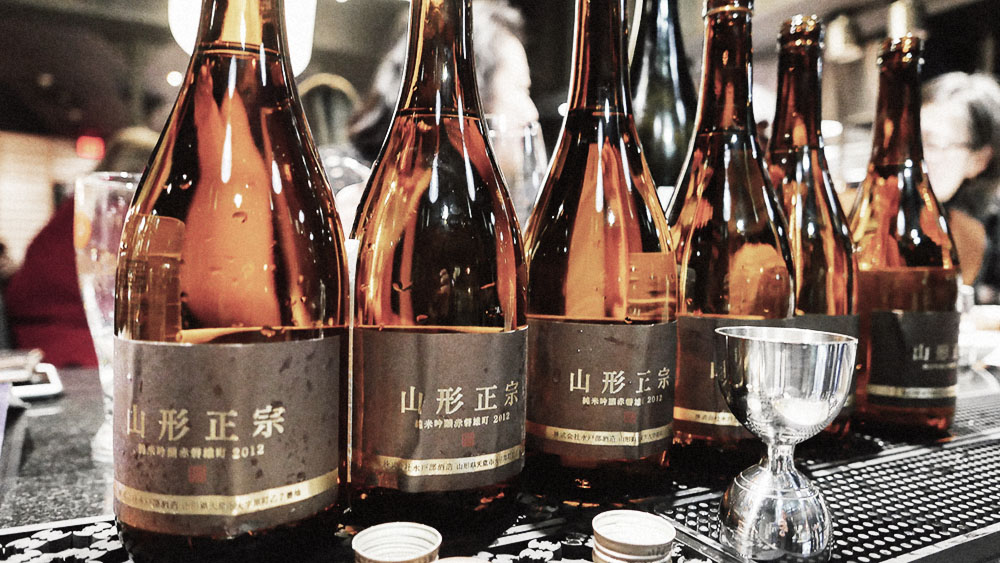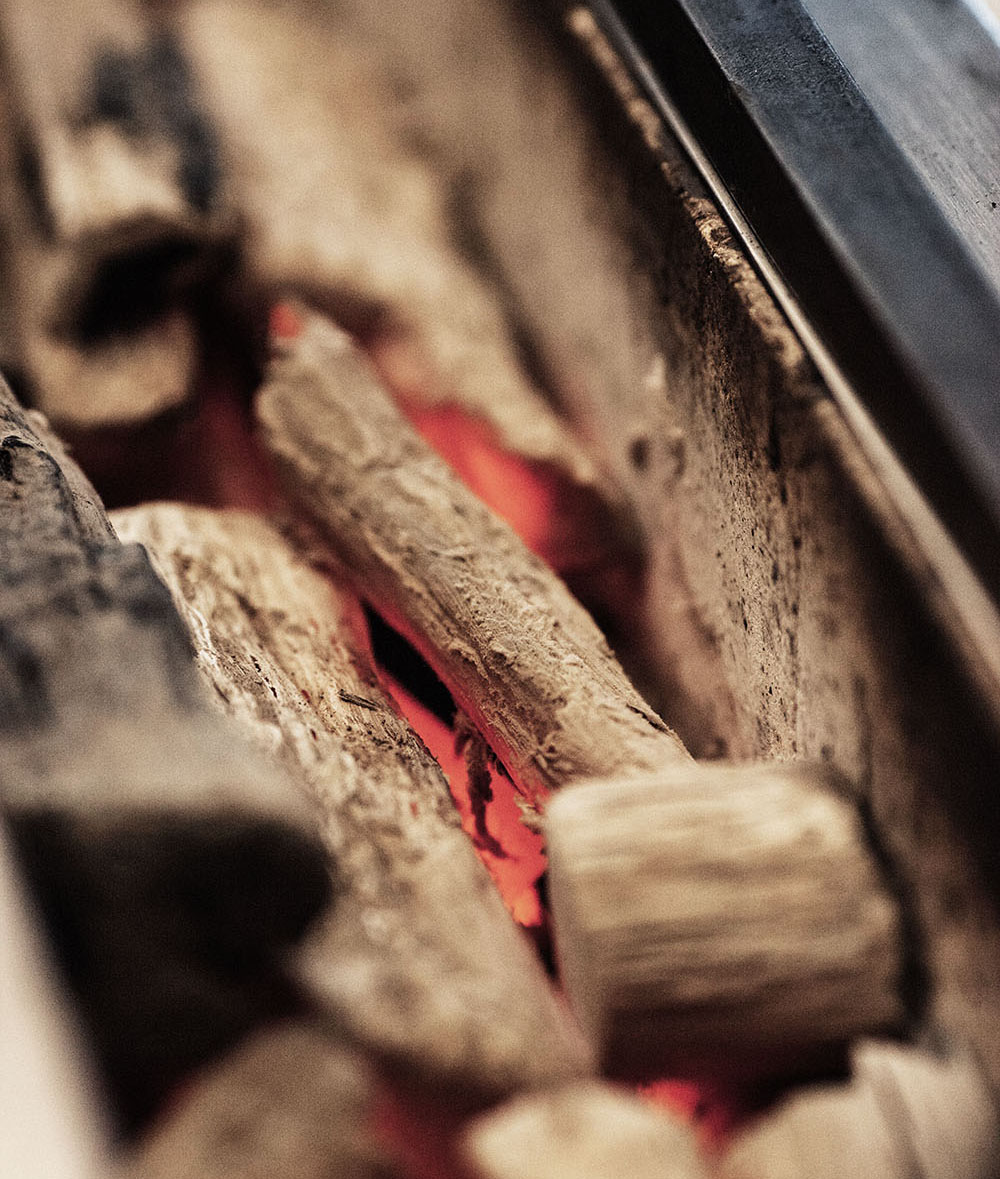Chef Darren MacLean, owner and mastermind behind Calgary’s Shokunin, has often been described as opinionated, outspoken, maybe even aggressive or crazy. But that’s not the vibe I got from him. In a society that’s made it easy to hide behind staged photos and false public façades, MacLean is an authentic, honest and vibrant voice, proudly exploring the culinary arts and giving voice to the issues that many chefs and independent restaurant owners face today. On any given day, his Twitter feed is filled with tweets encouraging equality, visibility for the reality of costs, food sourcing and quality in restaurants, as well as retweets and comments about the political health of North America.
MacLean started working in the restaurant industry when he was 12. His early start was prompted by financial need; and while he tried to explore other career paths, the kitchen kept pulling him back. After studying finance at Mouth Royal University in Calgary, he left and enrolled in Stratford Chefs School in Ontario. He’s worked in a variety of restaurants, spanning the spectrum from greasy-spoon to high-end dining. In 2012, he opened Downtownfood with some colleagues, a “new Canadian bistro”; there he planted a rooftop garden that grew more than 40 varieties of herbs, fruits and vegetables, as well as cultivating honey used in a craft beer made by Calgary’s Big Rock Brewery. In 2015, after Downtownfood closed, he travelled to Japan to experience the culture and cuisine, bringing his experiences back with him in the form of Shokunin, a Japanese izakaya-style restaurant that introduces Calgarians – and anyone who enters Shokunin, for that matter – to authentic Japanese cuisine.
I spoke to MacLean about his love of cuisine, what it’s like trying to get people to try his food, especially since it’s not sushi, and how Canadian cuisine is playing out on the global scale.
What’s your culinary philosophy?
I love cuisine, I’m a student of cuisine. I just love cuisine. So my focus has always been on that side. I just love to eat, and those are the flavours. I would say I’m a student of cuisine. I’m a mad scientist of cuisine. And right now I’m a student of Japanese cuisine. I would never call myself a master, or anything like that. Japanese cuisine was a natural progression of a lot of interest over a lot of years, to really try and hone in and learn about that.
How did you develop an interest in asian cuisine in general and Japanese cuisine specifically?
All of my friends when I was growing up were Chinese …. So that’s where that started. Ultimately it started with, my mom is a good cook, so I understood what flavours were. Then I had a beautiful introduction through my friends, through dim sum and steamed buns and barbecue pork – all of my friends were Chinese and Vietnamese.
Gaining an interest in Japanese cuisine, it was learning from Tetsu Mori. I was working as a ladies night server and bartender at Cowboys. And that group just happened to own this restaurant where this really amazing chef Testu Mori was making sushi. He was so passionate about not mixing his rice. He’s changed. He’s very different now, but at the time he was really neurotic; he didn’t want to change anything. He was hyper Japanese. He taught me about rice. It’s the first time I ever ate raw fish.
It just was this transition of eating different cultures, gaining different friends, experiencing different sides to the world. It was kinda jumbled mess. With Testu, I saw focus and a beauty of the cuisine. But I didn’t cook Japanese for 10 years after that. Until really at Downtownfood we did some, in a fusion style. I still went full French and did the classic training; it’s just always an interest that I’d always had.
What is your biggest hurdle with Shokunin?
Educating people that Japanese food is more than sushi. We’re definitely kind of the first concept of our kind; we are the first yakitori bar in Calgary, that’s for sure. There was somebody else that tried to do yakitori … but that was almost 15 years ago, so it has been tried and it hasn’t worked out. We’re fortunate that the Calgary dining scene has matured. Arguably I’d say it’s one of the best in the country right now, just with diversity and people trying things and pushing the envelop. There’s quite a few restaurants trying to push here.
In other ways, Calgary is a real mix. It’s half and half. Calgary loves to hype of their restaurants, but it also suffers from the xenophobia of dining …. What I mean by that is: Japanese is sushi; Chinese is sweet-and-sour pork and ginger beef; Italian is pizza and pasta; Germanic food is pirogies and strudels; French food is escargot and baguettes. We look at a small part of the cuisine that we relate to and enjoy, and dismiss the rest of the cuisine. And in doing so we dismiss a large part of that culture. And I don’t think people really reconcile culture with food as much as they should. For me, food has been culturally relevant and that’s because of the people I grew up around.
I think the biggest hurdle is getting people out of their comfort zones with anything …. We stay in relationships … and jobs that we’re comfortable with because the alternative is scary. And it’s the same thing with food. I think it’s a depressing way to live. It’s like only have sex in the missionary position your whole life …. It’s like being willfully colourblind. Nothing against people who are colourblind, but you wouldn’t choose to be colourblind, because you’re just missing out on this f*ing big world of colour. And culinary arts are the same thing. You can tell, that’s my frustration, is getting people out of their comfort zone.
It’s ludicrous what we’ve trained ourselves to believe is real and not real. The movement of millennials seeking authenticity, but we seek authenticity through an Instagram feed. So it’s all doctored, it’s all manicured and it’s become like that for food. And people just want what they know, and that’s across the board. That’s been the biggest challenge for us and I think any restaurant in the world.
What do you think about recent attempts to define Canadian cuisine?
We limit ourselves constantly in life. I’m kind of into this whole minimalism thing and rejecting materialism and all this kind of crazy stuff …. I spoke to Food on the Edge recently, I was in Ireland, and they were asking us to define Canadian cuisine. And there’s all these amazing chefs like Massimo Bottura, the number one chef in the world; Justin LeBoe from here in Calgary, he just got number 10; Connie DeSousa and John Jackson from CharCut Roast House. So I’m sitting there, going, ‘holy shit, this is amazing to be here’. and they’re always ‘what’s Canadian cuisine, what’s Canadian cuisine’. I just said ‘I’m not interested in what is the quintessential Canadian cuisine’, because any time you try to define a cuisine, you try to put it in a box, you limit the possibilities of that cuisine. So I may not know what Canadian cuisine is yet, but I’m not going to try to define it because it’s still evolving, it’s such a young country. It’s just like France, and Japan and all of these different cultures that developed a cuisine. Tempura was a Portuguese dish brought over in the 1600s, and over a 400 year span, it became something distinctly Japanese. And so it’s very interesting, it’s like, you know, look at prosciutto and the cured hams. A lot of that influence came from the people of Gaul and what is now modern day France…. French cuisine is an amalgamation of Roman influence, Germanic influence. Morocco is a beautiful example of a cuisine influenced by the French, the English, the Muslim, Christian, different traditions in one country.
“Any time you try to define a cuisine, you try to put it in a box, you limit the possibilities of that cuisine. So I may not know what Canadian cuisine is yet, but I’m not going to try to define it because it’s still evolving, it’s such a young country.”
With Canadian cuisine, one of the trends I’ve found is that there’s, like you said, not really a box to fit it into, it’s more the blending of different cultural backgrounds with local ingredients. Is that what you’re doing at Shokunin?
That’s always been our philosophy from day one. When I started my first restaurant Downtownfood, a lot of people said to me ‘oh you’re just mix-matching’ which I disagree with. Daniel Boulud has one of my favourite quotes of all time, he said “Café Boulud is a French restaurant, but our culinary palate has no geographic boundaries”. It’s one of the most eloquent beautiful statements in cuisine today. And that’s exactly how I look at Canadian cuisine. We have a culture that embraces diversity and other cultures, and it’s vibrant. So any culture’s cuisine, whether they want to admit it before, is reflected by who has lived there. You know London has some of the best curry in the world, because India was a British colony and the spice trade and then they had all kinds of people from Indian who came willingly or unwillingly to work in London and come to be in London. You know, when you talk about kabab, ‘oh we’ve got to go to London, we’ve got to try kabab, you gotta go for curry’. You’re like what the f***, I’m in London. So here’s a country, it’s just about having time to develop.
So I would say every country’s identity is defined by those within it and then further defined by the ingredients that are around them. So I, for example, I’m doing Japanese food in Calgary…. It’s in a very Japanese style, but we’re using very Canadian ingredients.
So I that think we have to get out of this mentality of trying to define it by maple syrup and poutine, which are beautiful and amazing products and I love them. But Canadian cuisine is literally, Canada. People forget the youth of this country. We’re 150 years old. France is a 1,000 years … So we’re just younger. So in 500 years there will be a Canadian cuisine that’ll be recognizable.
We used to say in my last restaurant Downtownfood that we’re serving true Canadian cuisine, and we respect and honour the traditions of the people who have come to live in this country while using the local ingredients that we have here.
And you’re following that philosophy at Shokunin?
We follow the philosophy here, there’s a philosophy in Japanese it’s called chimono, it’s used in kaiseki cuisine quite a bit. It means to use what’s around you, roughly translated.… We’re definitely using hyper local, hyper seasonal, we just happen to put Japanese techniques and apply them to our ingredients. And yes we use some fish obviously from the Osaka Fish Market; we’re using freshly grated wasabi, we’re one of the few restaurants to use it. It’s being grown in British Columbia, we can’t grow it here, we’re trying. We use local chickens, we use local beef, we use local pork. The miso’s coming. We’re actually starting it, we’ve made our own, it’s actually going to be ready in about two months. It’s taken about a year to ferment. And we’ll using our own miso that was made with Canadian-grown soya beans. So this is the direction that the restaurant is moving in.
And as a restaurant, we’re young. We’re just over a year old, so some of the projects that we’ve started have now started to kick in. So hopefully in a year, we’ll be using 100% our own miso made with Canadian soy beans. Is soy beans native to Canada? No, but it is grown here.
And that’s absolutely our philosophy. We use Japanese techniques married with what I believe to be some of the best ingredients in Canada, if not the world, found here in Alberta.
It’s interesting to hear about the different produce that people are growing that aren’t native to Canada.
Yeah, we do that. We grow our own sansho, in partnership with a farm in the Okanagan. Kinome is another plant that we grow locally; well as local as possible, it’s eight hours away. We grow a Japanese turnip call kabura, which is really fantastic; that’s coming onto the menu in a couple weeks here. Our cocktails, we forage elderflowers and then we ferment them and add sake to them for sake cocktails. We use the first seasons apricot blossoms from the Okanagan, I know I’m talking about BC, certain things we don’t have here, but we do have elderflowers locally, so we actually just go out and pick elderflowers in the neighbourhood, and fuse them into different syrups and ferment them for our cocktail program, because those floral flavours work so well with the premium sake that we use.
You import your sake from Japan, correct?
All of our sake is Japanese, yes.
And you also have a locally-brewed rice beer?
Yeah! So we’re 90 percent sure it’s the first of its kind. Big Rock Brewery is a big brewery here in Calgary and they do a microbrew program. So, it started with Killer Buzz [for Downtownfood]. We were the first restaurant to have bees on the roof for the purposes of brewing a beer. Other restaurants have had it, but we did it specifically so we could brew a beer that was Downtown’s beer. So it started there and I realized that beer is such a beautiful conduit for flavour. And I’m not talking about [artificially] cheesing it up with raspberry – there are some beers that are flavoured artificially. And one thing that I noticed with Killer Buzz, the first beer that we did using the honey from our rooftop garden, a, the honey tasted totally crazy. It was so rich and deep, it was the coolest thing. And the beer became that. So we did this experimental beer. They just basically did it. And they’re so talented at Big Rock, Paul’s a brilliant brewmaster, and he came up with the Killer Buzz. It was really interesting.
I went to Japan a little while later and there’s this beer called Suntory Premium Malts, you can’t get it here. It’s this really easy drinking, delicious crazy beer. It’s made with Alberta barley, ironically. And so I thought, I’d love to do a beer in keeping with this style. So that’s what we did.
I’m always interested in things that haven’t been done. We have an amazing brewer on the west coast, Crumble Island Sake Brewery, he makes sake and he’s growing rice, and so we use his sake kasu, that’s the leftover lees from sake production in the fermented rice, as a fermenting agent in the beer along with rice that was grown in the lower mainland, as the base. And the beer does use barley as well, like the Suntory. Then we were just able to use a check malt and a local hop in combination and we created this really interesting beer that’s incredibly popular and brewed exclusively for the restaurant by Big Rock whose obsessed with making really cool local beer, even though they’re on a larger scale. It’s almost like a cream ale and a lager together, it’s got these amazing underlying notes of almost sake-esque sweetness that really pairs well with salty grilled yakitori, that we cook over real Japanese binchōtan that we import. We’re working on trying to find… our goal is in a few years we’d love to create Canadian oak binchōtan and using that exclusively in the restaurant.
Chef MacLean’s passion for food and culinary exploration is something he shares with Quench’s Mav Chefs. In order to be a true Maverick, you need this passion – this drive to help people break out of their preconceived notions of what food should be and help them discover the true flavours of the world. Canadian cuisine may be new, and undefinable, but our 2017 Mav Chefs are making their mark on the definition. And, 500 years from now when Canada does have a cuisine of it’s own, true food artists like MacLean and Quench’s Mav Chefs will be the ones who helped make it happen.

